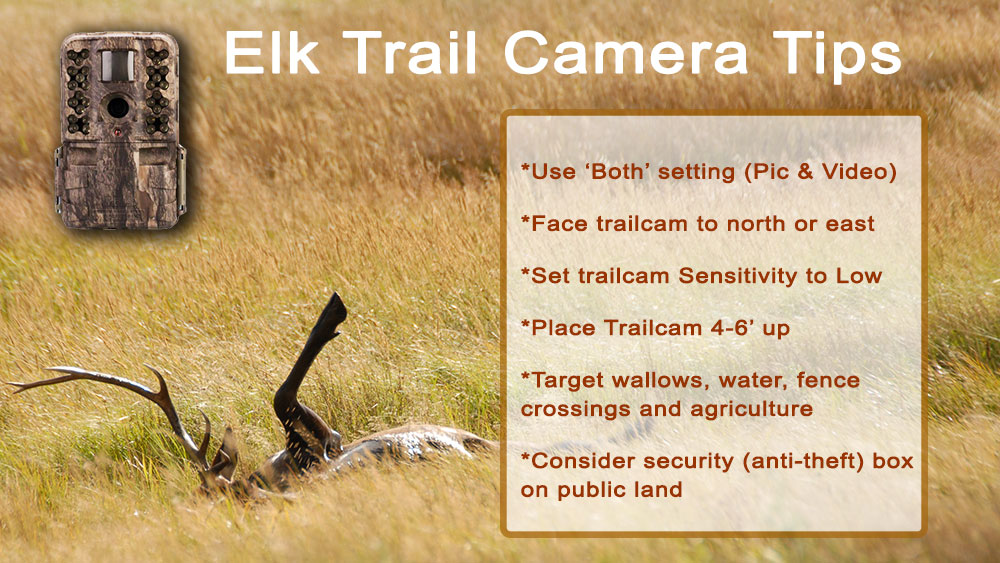Tips for using Trailcams for Elk Hunting
If you're not using trail cams, you may be missing out!

Post Your Elk Trailcam Pics Here!
It was opening week of the Arizona Archery elk season and I was hiking a south facing slope with Outfitter, Steven Ward. We had been hunting all morning when we came across a remote spring. There was a wallow next to it. Steven pulled out a Moultrie trail camera and placed it on a tree. He sets the M-990i to 'Both' (which means the camera will take a photo, followed by a video) marks the spot with his GPS, then we continue hunting. We would return to check on the camera a few days later.
For hunters, and outfitters like Steven Ward, a trail camera is a critical tool for both pre-season, and in-season Elk scouting. The camera shows him what caliber bulls are using a waterhole, fence crossing or wallow, how many elk are frequenting it, and the time of day they typically visit. Since we are hunting public ground, it will also show how many hunters may visit this spot during the season. All this data is vital to maximizing your options and informing your decisions.
Best places for Elk Trail Cameras (priority order):
Active wallows - by far the best place to hang a trail camera is on an active wallow. The more secluded the better. These mud pits are magnets for elk in all areas, but they are especially useful in hotter climates like Arizona and New Mexico.
Waterholes - Many public and private elk grounds contain waterholes. These are often man-made and used by both cattle and wildlife alike. Elk need to water, and the waterhole is the most important location to hang a trail camera after active wallows.
Fence crossings - while hunting in Arizona we found what can only be described as an 'elk highway.' The ground was beaten down on both sides of a fence where the top strand had been removed to encourage wildlife crossings. Putting a camera here will give you a good indication of elk movement - along with an inventory of the type of bulls frequenting that locale.
Agriculture - When I hunted with Wes Atkinson in Colorado, he would place trail cams at strategic locations where the elk moved off an alfalfa field every morning. He ran his cams starting long before the season and kept them active until the season was closed. The elk would generally stay on established trails where there was a decent chance one of them would walk by a trail camera. Unfortunately, the elk tend to wander, so on a 1000-acre alfalfa field, there could be 50 trails for ingress and egress to the crop. Running cameras on crop fields is not as effective as wallows and waterholes.
Hanging Tips for Elk Trailcams
Many of the same tips associated with hanging trail cams for whitetails apply to elk as well. With a couple of noted exceptions.
- Face the camera to the North and East - This will eliminate direct sun tripping the camera and blowing out your photos. It will also provide for the best quality lighting and colors since the animal will be lit up, rather than back-lit.
- Place the camera at 4-6' level - Elk are big, tall animals. They tower over whitetails so it's best to hang them higher than you would for deer and bear. The higher you can get, the less non-target animals you will capture, and you will have a clear view of antler size.
- Adjust your trail camera sensitivity - Unless you are trying to capture elk at a distance greater than 30' we suggest you set your camera sensitivity to Low. Elk are big animals and they will trip a low sensitivity setting, but birds (that frequent water holes) along with a host of other small animals will not be as likely to trip the sensor, cluttering up your card and killing your batteries.
- Use theft deterrents - While the vast majority of elk hunters are decent, honest people, if you are hunting public land there's a possibility that your trail camera may be stolen. Consider an anti-theft box to deter thieves, or nosey hunters who want to get access to the data on your card.
- Photo/Video settings - For Elk wallows and waterholes we set our Moultrie cams at a '30 second' timeout, photo and video (Both), and a 30 second video clip at Full HD. For fence crossings and agriculture, we prefer to use photo (only) with a 10 second timeout.
Summary
A week after Steven and I hung that Moultrie trail camera at the wallow, we returned to see what had tripped the card and whether it was worth hunting over that wallow. We noticed a bear was visiting the waterhole every day, along with a spike bull and a couple of cows. Since not a single mature bull elk had visited, we determined that there were better locations to hunt. We pulled the camera and moved it to a waterhole, dozens of miles away, where we later learned of a nice 6x6 bull was frequenting every evening at dusk.
While just about every whitetail hunter uses trailcams, most elk hunters do not, and in my opinion that is a mistake. Trail cams can be an invaluable tool for your pre-season and in-season scouting and adds a fun and memorable dimension to your elk hunt.






